homes & gardens -- 2025
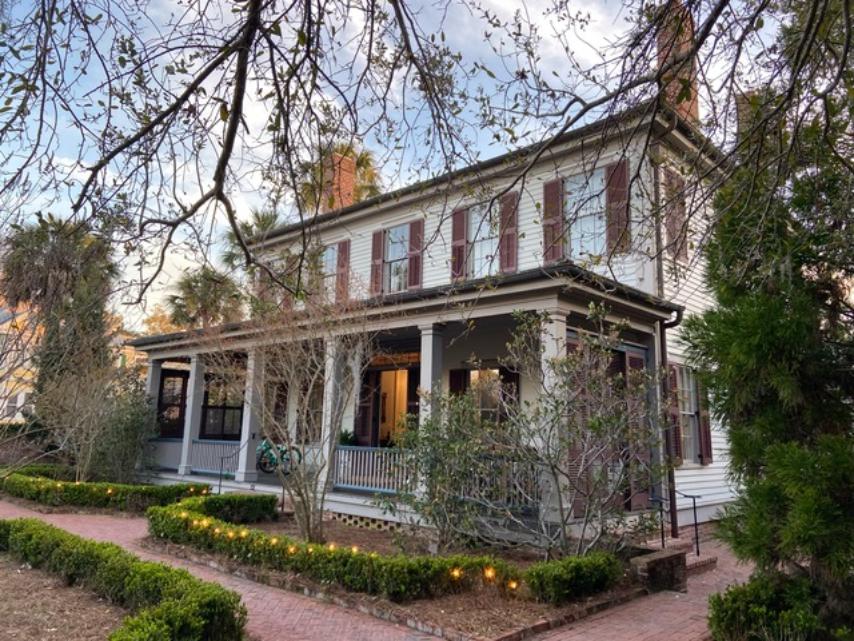
featured home -- 2025
1. The Dr. Alvan W. Chapman House
We are honored to have this historically significant and elegant structure as our 2025 Featured Home. Painstakingly restored years ago with the intent of becoming a museum, the Chapman House now comes to life as a private residence, thanks to Lauren and Patrick Ferguson.
For many years, this five-bay Classical Revival house served as the home of Dr. Alvan Wentworth Chapman—a physician, scientist, and eminent botanist—whose research and writings on Southern flora earned international acclaim. Born in 1809 in Massachusetts, Dr. Chapman moved to Florida in 1835 and settled in Apalachicola by 1847, where he lived until his death in 1899.
Active in the community, Dr. Chapman served as county judge, mayor, and collector of customs. Among the many plants named in his honor is the Chapman Rhododendron.
The house features full-length central halls on both the first and second floors, each flanked by four rooms. The original kitchen would have been located separately from the main structure. In 1921, the home underwent a major remodel that included substantial additions.
Helen Tudor, a patented scientist and engineer, purchased the house in 2008 from a real estate broker who had used it as office space. She then enlisted the help of a New York City architect to oversee a comprehensive restoration project.
With no original construction documents available, historic photographs helped guide the process. Inappropriate enclosures and later additions were removed to return the home to its appearance during Dr. Chapman’s lifetime. This included the removal of the enclosed front porch and second-story addition, along with the restoration of the original colonnade.
As president of The Chapman House Museum Inc., Tudor was meticulous in her mission to honor Dr. Chapman’s life and scientific legacy. She added her collection of historic furnishings to the home’s interior and installed a pair of historical markers outside the house.
Plans also included a “Chapman Reading Room” and the restoration of the surrounding garden. Tudor envisioned a 19th-century landscape featuring heirloom plants and native specimens originally discovered by Dr. Chapman.
Although the museum was nearly ready to open, the vision was never fully realized. In September 2020, Patrick and Lauren Ferguson purchased the property from Tudor. “Everything was just absolutely amazing,” Patrick recalled. “If it required a level of 5, she gave it a 10. It was a turnkey museum.”
Patrick, a real estate investor, and Lauren, a real estate broker—both from Oxford, Mississippi—have proven to be exceptional stewards of the home. In a separate transaction, they also acquired Tudor’s magnificent antique furnishings, including 18th- and 19th-century Scandinavian furniture, ornate mirrors, chandeliers, and White Ironstone china.
Since moving in, Lauren and Patrick have worked to revitalize the gardens, which had become listless and overgrown in the years since Tudor first planted them.
“A lot of what we did involved taking it from a museum and turning it back into a home,” Lauren explained.
True to their commitment to share the Chapman House with the community, the property is now available for special events such as rehearsal dinners. Additionally, the garden suite, and adjacent cottage and carriage house are offered as short- and long-term rentals.
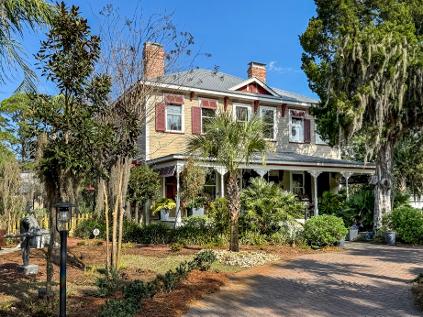
2. John W. Wakefield House
“Second time’s the charm” is an apt phrase when describing this historic house and Randy Fike. Years ago, when moving from a colder climate to Cape San Blas, Randy and his late wife saw this house and made an offer.
“But we withdrew it,” Randy recalls. “Although it was beautiful, we moved to be at the beach.”
After his wife passed away, Randy once again felt drawn to Apalachicola—and to this house. In 2020, he knocked on the door and presented an offer to the owner, architect Warren Emo. Fortunately for Randy, Warren was retiring and interested in selling.
Photographs in the entryway depict the house’s extensive renovations over the years. A fire in 1903 destroyed the original Wakefield house. In 1905, builder George Marshall constructed a new home for John Wakefield on the same site, but facing Avenue C. In the 1930s, the house was divided into apartments, with the owner retaining one unit. In 1944, the house once again succumbed to fire. The structure was saved, but the roof was lost, and the second floor suffered significant damage. In 2006, the house underwent a full renovation.
Randy had barely settled into his new home when he began adding his personal touch to the interior. His unique style is evident in the hardware, lighting, ceiling fans, and artwork he selected—the “fun stuff,” as he calls it. His choice of new countertops, fresh paint, and refinished floors brightens the kitchen. His design extends outdoors, with custom shutters, rafter tails, and sculptures punctuating the colorful landscape.
Randy jokes that while the iron accents downstairs make it feel like a man’s space, the upstairs—where his partner, Cathy Gordon, works—is bright and inviting. Fortunately, their rescue dog, Murphy, doesn’t seem to mind either way.
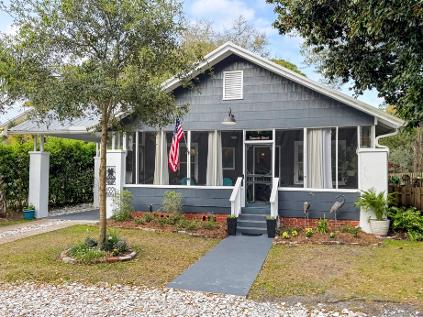
3. Plum Tree Cottage
“We tried to make the best of a small house,” says Bill Avery, who purchased this bungalow in 1994 as a weekend getaway. Married in 2012, Bill and Anne moved to Apalachicola full-time in 2019 when Bill retired—for the third time!
It is believed that the cottage once resembled the neighboring bungalows—dwellings supposedly built during World War II at the Apalachicola Army Airfield and later moved into town in the 1950s. Bill, however, believes this house was built post-war in 1946 after a fire damaged the original structure. He cites its brick foundation as evidence, noting that the others are built on piers.
What is certain is its undeniable charm. With the help of local contractor Earl Duggar, the Averys renovated their home last year. Removing a wall created a more open living area, while eliminating a small porch with leaky jalousie windows increased the square footage of the primary bedroom.
The couple spends much of their leisure time on their new back porch, which features repurposed Homart metal cabinets, a grill, and a bar top made from pecan wood.
During the six-month renovation, Anne and Bill lived in the studio at the back of the property. Once a simple “tar paper shack,” the space now serves as a guest room, bathroom, office, and laundry room. In true "Only in Apalach" fashion, they even share a tool shed with a neighbor.
Bill enjoys gardening, while Anne considers herself the creative visionary. What could have been an ordinary view from inside is instead a lush utility garden filled with orchids and air plants.
Birds, hummingbirds, and butterflies frequent the garden, which is framed by cypress and oak trees, staghorn ferns, a night-blooming cereus, and an abundance of Chickasaw plum trees. These native plums, known for their stunning blossoms, inspired the home’s name.
A unique feature inside is a compass rose inlay in the living area. Instead of the traditional four cardinal
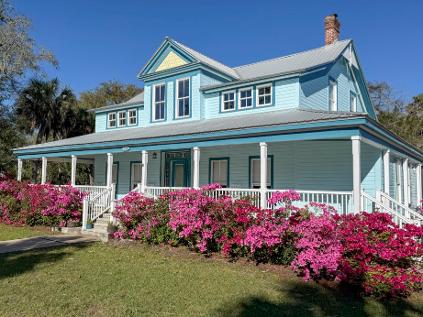
4. Granberry-Henry-Gordon House
Because he had designed and built their solar home in New Mexico, Phil Fuerschbach—a mechanical engineer—was no novice when he and his wife, Marcie, embarked on a ten-year renovation of this Folk Victorian house in 2012. After making a few initial improvements to make the house habitable, they began work on the adjacent apartment, which would serve as their temporary home during the restoration of the main house.
“When we bought this place, we thought we could move into the 1959-built apartment, but it was unlivable,” says Phil. After discovering that all the sills were rotten, his first project was to repair the deteriorating structure.
The main house was originally built as a single-family residence, but the upstairs was later converted into two apartments. During their room-by-room remodel, Marcie and Phil found the name "Joseph Granberry" scribbled on boards inside the walls. Granberry purchased the lot in 1903, built the house, and sold it in 1907 to Crawford Henry and his young wife, Julia. From 1913 to 1922, Henry served as the Apalachicola postmaster. But the Great Depression was hard on the Henry family, and they lost the house to bank foreclosure in 1937.
Forest Gordon and his wife, Sarah, were the next owners, maintaining the property until 1989, during which time many locals—including schoolteachers—lived in its various spaces.
Finding the cobbled-together floor plan unworkable, Marcie and Phil set about reconfiguring it. “We had four bathrooms, two laundry rooms, and two kitchens in this house. We moved everything,” says Phil. The couple brought three of the original six fireplaces back to life, replaced all the systems, and leveled the floors. They were assisted by their children, visiting friends, and skilled artisans: Tom Connor, Pete Olson, and Mike Young.
From the house to the apartment, then upstairs and finally downstairs, Marcie jokes that they moved four times—all within the same address. And with parties at every step, the entire house has been joyously celebrated!
A fiber artist, Marcie showcases her innovative textile art throughout the home.
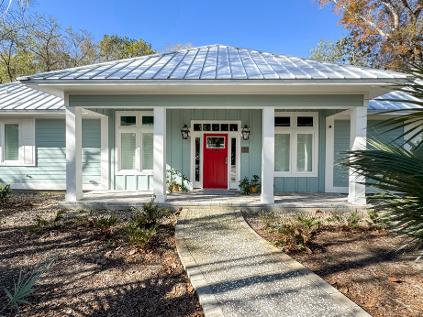
5. Hoskiti
Welcome to Hoskiti, the Desloge residence on The Hill. Inspired by the Apalachee Indian term for "blessed house," the name perfectly captures this slice of paradise. Completed in early 2024, it serves as their launchpad for exploring the Panhandle and beyond.
Bryan and Jeri, who live in Tallahassee, also have a house in St. Teresa that Bryan built 20 years ago. But now that the children are grown, they’ve sought out a more active—albeit eclectic—community. Bryan has cherished memories of visiting Apalachicola since childhood, and with the marina just a stone’s throw away, they’re planning to embark on the Great Loop later this year.
Hoskiti beautifully reflects their adventurous spirit and deep appreciation for the rich history of the Apalachicola area. Built by the talented team at Salty Dog Construction, the home features a porch with a fireplace that pays homage to the town’s legacy as the “Oyster Capital of the World.” Inside, the décor is a curated collection of treasures from their travels—mementos of Bryan’s adventures across 108 countries (and counting!).
Hospitality runs in Jeri’s DNA. She recently sold her two restaurants and catering company in Tallahassee, but her passion for hosting lives on. The open kitchen and the cypress dining table—crafted from wood pulled straight from the Apalachicola River—offer seating for ten and the perfect setting for entertaining in style.
Hoskiti is more than just a house—it’s a testament to Bryan and Jeri’s love for adventure, community, and the comforts of home. Rooted in history and designed with the future in mind, it blends the charm of Apalachicola with the warmth of two well-traveled hearts. Whether they’re setting off on new journeys or gathering friends around the table, Hoskiti stands as a celebration of a life well-lived—and a reminder that the best stories are always shared at home.
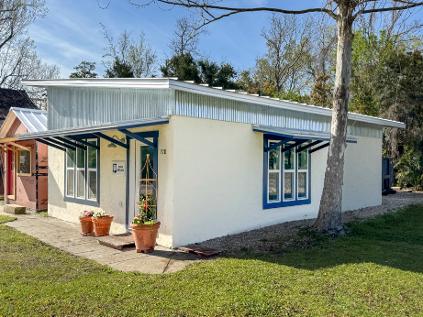
6. Glad Hat Pottery
Two local preservationists saved the historic Matt Raiford House—which became the home of Diane and Dave Peck—from demolition. In turn, the Pecks are helping with the revitalization of 8th street, once a vibrant business district on The Hill.
After living in their home for a year—and even featuring it on the 2023 tour—the Pecks began searching for a space to house Diane’s pottery studio and Dave’s woodworking shop. When they couldn't find the right building, they discovered this cluster of three structures. Zoned C-2 for retail, residential, and commercial use, the corner property had once been home to a laundromat, fish market, upholstery shop, and cobbler.
Undeterred by the overgrown vegetation and the buildings' derelict state, the Pecks purchased the property. “It was pretty crazy,” says Diane. “I can’t even describe it. We had to take this one (her studio) all the way down to the cement blocks.”
Renovations are well underway. The middle building will serve as a living space for the Pecks’ daughter when she visits Apalachicola. “It’s very small, but it will have a little kitchen area, a bathroom, and a back porch,” Diane explains.
The third building is designated as a woodworking shop. With the help of craftsman Greg Krivonak, Dave lifted and leveled the structure, uncovering relics of the past—8-track tapes, old bottles, and baseball cards from the late ‘80s and early ‘90s. Exposed rafters now replace the rotten ceiling. “We’re trying to salvage whatever we can, but termites have done a number on these walls,” Greg notes.
After a 12-year hiatus, Diane has returned to pottery, spending hours in her new studio, Glad Hat Pottery. Meanwhile, Dave's first project in the woodshop will be restoring his 12 ½ Herreshoff —one of the finest small boats ever designed—while Greg plans to craft furniture and cabinetry.
We can’t wait to see it all come together!
Diane, who specializes in handbuilding and wheel-throwing, will be demonstrating these techniques throughout the day.
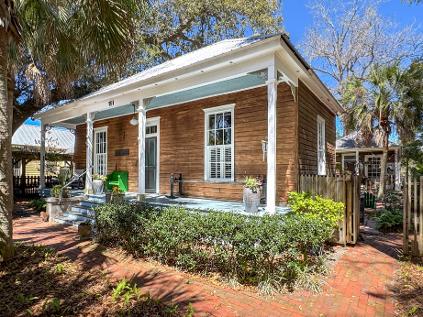
7. Phillips-Doherty House
One of the most intriguing residences in Apalachicola sits nestled in a wooded lot, hidden behind a distinctive entranceway crafted from shrimp boat outriggers. Greg Phillips and Betsy Doherty assembled the home on its current site in 2000. The compound consists of a Florida Cracker house and two shotgun houses, all relocated from a nearby lot.
One of the shotguns was in very poor condition, and the house was a wreck, says Greg, a skilled craftsman known for his exceptional renovation work. “It had no kitchen, very few windows, no bathroom, and the porch didn’t exist.”
Betsy and Greg purchased the structures from Christine Rhodes, whose late husband, Chester, was a spirited entrepreneur and a jack-of-all-trades. Chester was known for buying, moving, tearing down, and renting out houses, Greg recalls. Knowing Greg would need doors and windows, Christine offered him Chester’s collection of reclaimed materials.
One example is the corner cabinets Greg built using salvaged wood and doors from Chester’s inventory. He also constructed the bookcases, kitchen cabinets, and pot rack. The kitchen island, a standout feature, was a Christmas gift he made for Betsy. “The intention was never to sell,” says Greg, who moved to the area in the ’90s from coastal Alabama. Many architectural pieces he collected over the years—from New Orleans to Mississippi to Mobile—are now incorporated into the home.
Fast forward to 2020, when Bonnie Kellogg acquired the captivating property. Once an office and woodworking shop, the reconstructed shotgun houses now serve as rental units.
Although she has lived in many homes, Bonnie says this is the only one where she truly loves the kitchen. “If I have three or four guests, we sit at the island in the kitchen. If I have eight, we begin the evening with appetizers and a drink in the kitchen, then move to the porch, or the dining room for our meal. Occasionally, I set up a table in the courtyard by the fountain. It’s a wonderful house for entertaining that I love sharing with my friends here.”
Greg is pleased Bonnie kept the vintage refrigerator—a unique feature he had carefully placed to be visible from the living room rather than opting for a modern appliance.
“Did you ever use it?” Bonnie asks.
“No, it never worked,” Greg admits with a grin. “It was a liquor cabinet.”
8. Apalachicola City Square Community Garden
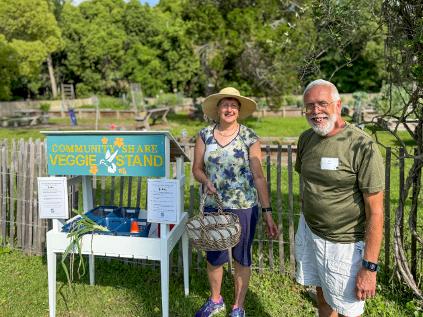
Whether you're an experienced gardener or a beginner ready to get your hands dirty, community gardens offer a chance to grow your own food, connect with others, and learn about edible gardening. Apalachicola’s community garden is no exception.
Established in 2011, the Apalachicola City Square Community Garden is a vibrant space where neighbors from all walks of life come together to cultivate healthy, beautiful food and medicinal plants.
To protect both the land and Apalachicola Bay, the garden follows organic, sustainable, and environmentally friendly practices. Gardening here is more than a hobby—it's a means to boost food security, enhance personal well-being, and build a stronger, more connected community.
Today, around 50 gardeners care for 30 raised beds, along with an orchard, a pollinator garden, and an herb garden. A Community Share Veggie Stand provides surplus produce and goods to the public, and a bi-weekly share program is held at the Pavilion, depending on harvest availability.
The garden is managed by a committee of five to seven members who help with community coordination, including processing memberships, collecting dues, and maintaining the site. A garden coordinator works closely with the committee, and a treasurer manages the budget. For a sliding scale fee of $40–$80, members receive a garden bed, water, and mulch (when available). Currently, there is a waiting list for membership.
On tour day, gardeners will be available to share insights and answer questions about the garden.